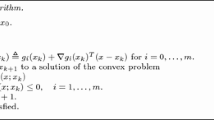Abstract
A heuristic optimization methodology, Dynamic Contraction (DC), is introduced as an approach for solving a wide variety of hard combinatorial problems. Contraction is an operation that maps an instance of a problem to a smaller instance of the same problem. DC is an iterative improvement strategy that relies on contraction as a mechanism for escaping local minima. As a byproduct of contraction, efficiency is improved due to a reduction of problem size. Effectiveness of DC is shown through simple applications to two classical combinatorial problems: The graph bisection problem and the traveling salesman problem.
Similar content being viewed by others
References
Bondy, J.A. and U.S.R. Murty. (1976). Graph Theory with Applications. New York, NY: North-Holland.
Bui, T., S. Chaudhuri, T. Leighton, and M. Sipser. (1987). "Graph Bisection Algorithm with Good Average Case Behavior," Combinatorica 7(2), 171–191.
Bui, T., C. Heigham, C. Jones, and T. Leighton. (1989). "Improving the Performance of the Kernighan-Lin and Simulated Annealing Graph Bisection Algorithms," Design Automation Conference, pp. 775–778.
Cormen, T., C. Leiserson, and R. Rivest. (1990). Introduction to Algorithms.New York, NY: McGraw-Hill.
Gabow, H.N., Z. Galil, and T.H. Spencer. (1988). "Efficient Implementation of Graph Algorithms Using Contraction," Journal of Association for Computing Machinery 36(3), 540–572.
Garey, M.R. and D.S. Johnson. (1979). Computers and Intractability: A Guide to the Theory of NP-Completeness. New York, NY: W.H. Freeman and Company.
Glover, F. (1977). "Heuristics for Integer Programming Using Surrogate Constraints," Decision Sciences 8,156–166.
Glover, F. (1986). "Future Paths for Integer Programming and Links to Artificial Intelligence," Computers and Operations Research 13, 533–549.
Glover, F. (1996). "Ejection Chains, Reference Structures and Alternating Path Methods for Traveling Salesman Problems," Discrete Applied Mathematics 65, 223–253.
Glover, F. and M. Laguna. (1993). "Tabu Search." In C.R. Reeves (ed.), Modern Heuristic Techniques for Combinatorial Problems, New York, NY: Halsted Press, chapter 3, pp. 70–141.
Goldberg, D. (1989). Genetic Algorithms in Search Optimization and Machine Learning. Menlo Park, CA: Addison-Wesley.
Goldberg, M. and M. Burstein. (1983). "Heuristic Improvement Technique for Bisection of VLSI Networks." Proc. Int. Conf. Computer Design: VLSI in Computers, pp. 122–125.
Grötschel, M. and O. Holland. (1991). "Solution of Large-Scale Symmetric Traveling Salesman Problems," Mathematical Programming 51, 141–202.
Holland, J. (1975). Adaptation in Natural and Artificial Systems. Ann Arbor, MI: University of Michican Press.
Johnson, D.S., C.R. Aragon, L.A. McGeoch, and C. Schevon. (1989). "Optimization by Simulated Annealing: An Experimental Evaluation; Part I, Graph Partitioning," Operations Research 37(6), 865–892.
Johnson, D.S., C.R. Aragon, L.A. McGeoch, and C. Schevon. (1991). "Optimization by Simulated Annealing: An Experimental Evaluation; Part II, Graph Coloring and Number Partitioning," Operations Research 39(3), 378–406.
Jones, C. (1992). "Vertex and Edge Partitions of Graphs." Ph.D. Thesis, Department of Computer Science, Pennsylvania State University.
Karmarkar, N. and R.M. Karp. (1982). "The Differencing Method of Set Partitioning." Report No. UCB/CSD 82/113, Computer Science Division, University of California, Berkeley.
Kirkpatrick, S., C. Gelatt, and M. Vecchi. (1983). "Optimization by Simulated Annealing," Science 220, 671–680.
Laguna, M., J.P. Kelly, J.L. Gonzales-Velarde, and F. Glover. (1995). "Tabu Search for the Multilevel Generalized Assignment Problem," European Journal of Operational Research 82, 176–189.
Lengauer, T. (1990). Combinatorial Algorithms for Integrated Circuit Layout. New York, NY: JohnWiley & Sons.
Levy, H. (1988). "A Contraction Algorithm for Finding Small Cycle Cutsets," Journal of Algorithms 9, 470–493.
Lin, S. and B.W. Kernighan. (1973). "An Effective Heuristic Algorithm for the Traveling Salesman Problem," Operations Research 21, 498–516.
Manber, U. (1989). Introduction to Algorithms: A Creative Approach.Menlo Park, CA: Addison-Wesley.
Padberg, M. and G. Rinaldi. (1987). "Optimization of a 532-City Symmetric Traveling Salesman Problem by Branch and Cut," Operations Research Letters 6(1), 1–7.
Padberg, M. and G. Rinaldi. (1990). "Facet Identification for the Symmetric Traveling Salesman, Problem," Mathematical Programming 47, 219–257.
Padberg, M. and G. Rinaldi. (1991). "A Branch and Cut Algorithm for the Resolution of Large-Scale Symmetric Traveling Salesman Problem," SIAM Review 33, 60–100.
Reinelt, G. (1991). TSPLIB-"A Traveling Salesman Problem Library," ORSA Journal on Computing 3(4), 376–384.
Saab, Y. (1995). "A Fast and Robust Network Bisection Algorithm," IEEE Transactions on Computers 44(7), 903–913.
Saab, Y. and V. Rao. (1991). "Combinatorial Optimization by Stochastic Evolution," IEEE Transactions on Computer-Aided Design 10(4), 525–535.
Author information
Authors and Affiliations
Rights and permissions
About this article
Cite this article
Saab, Y. Combinatorial Optimization by Dynamic Contraction. Journal of Heuristics 3, 207–224 (1997). https://doi.org/10.1023/A:1009631125956
Issue Date:
DOI: https://doi.org/10.1023/A:1009631125956




